A vanilla or chocolate cake is often the starting point for other cake flavors, so it’s important to have a perfect foundation for your baking projects. So getting down to basics today, I’m sharing my High Altitude Vanilla Cake recipe.
My vanilla cake is so soft, light and fluffy, thanks to a generous amount of buttermilk, with a delicious flavor from real vanilla beans and butter. The cake crumb is beautiful and moist, even days after baking. This is also an incredibly easy cake to make, requiring nothing more than just whisking the ingredients together in a bowl before baking. You’ll love this delicious and versatile high altitude vanilla cake recipe! It’s just the perfect choice for a birthday party or special occasion cake that will please everyone. And for an eggless vanilla cake, be sure to see the recipe variations section.
Looking for more high altitude cake recipes? Don’t miss this brown butter carrot cake, chocolate fudge cake, and mint chocolate chip cake.
Update: I originally published this recipe in 2015, but have updated the post and recipe in 2023.
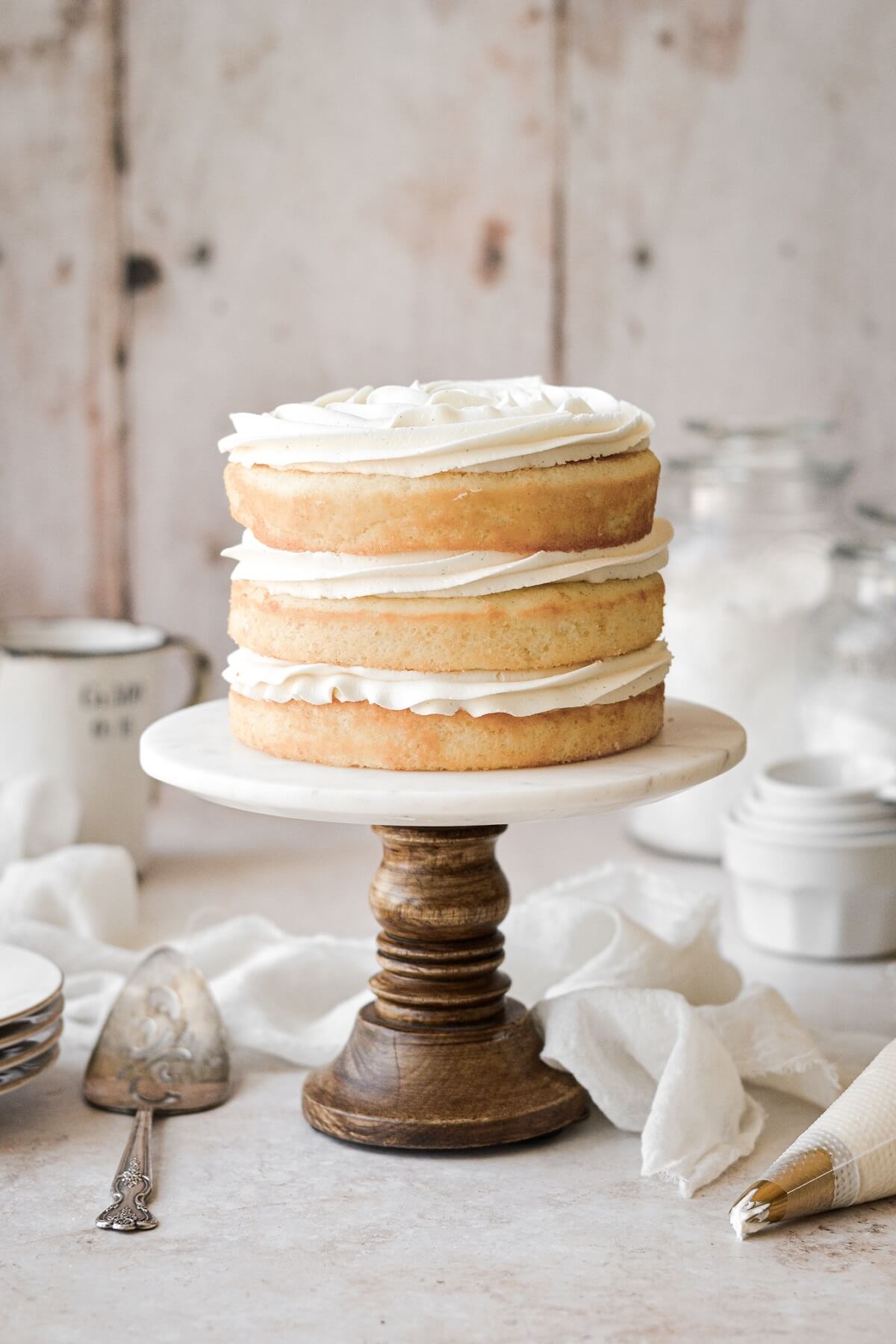
This site contains affiliate links. As an Amazon associate, I earn from qualifying purchases. This means that I may make a small commission if you purchase a product using those links. This in no way affects my opinion of those products and services. All opinions expressed on this site are my own.
Let’s Talk About Vanilla
I genuinely love vanilla, and I don’t think there’s anything plain about it, really. Vanilla is a complex flavor that pairs so beautifully with so many other ingredients. And vanilla beans are a very difficult crop to grow and cultivate, so I have great respect for vanilla!
About 80% of the world’s vanilla beans are grown on the island of Madagascar. In recent years, the cost of vanilla skyrocketed, due to a series of storms that ravaged the island, destroying the plants and driving up vanilla prices to almost 10 times what they were a few years before.
The other major contributing factor to the high price of vanilla is the fact that the plant is just so difficult to grow. Vanilla comes from an orchid plant, and while there are 100+ varieties of orchids, only one, the vanilla planifolia, grows vanilla beans. The hand pollination process is difficult and labor intensive, requiring skill and experience. The orchids flower just once a year, and the pollination must take place on that day. And after the harvesting the beans, they still need to be dried and cured. The entire process of growth to export of 1 vanilla bean takes a whole year.
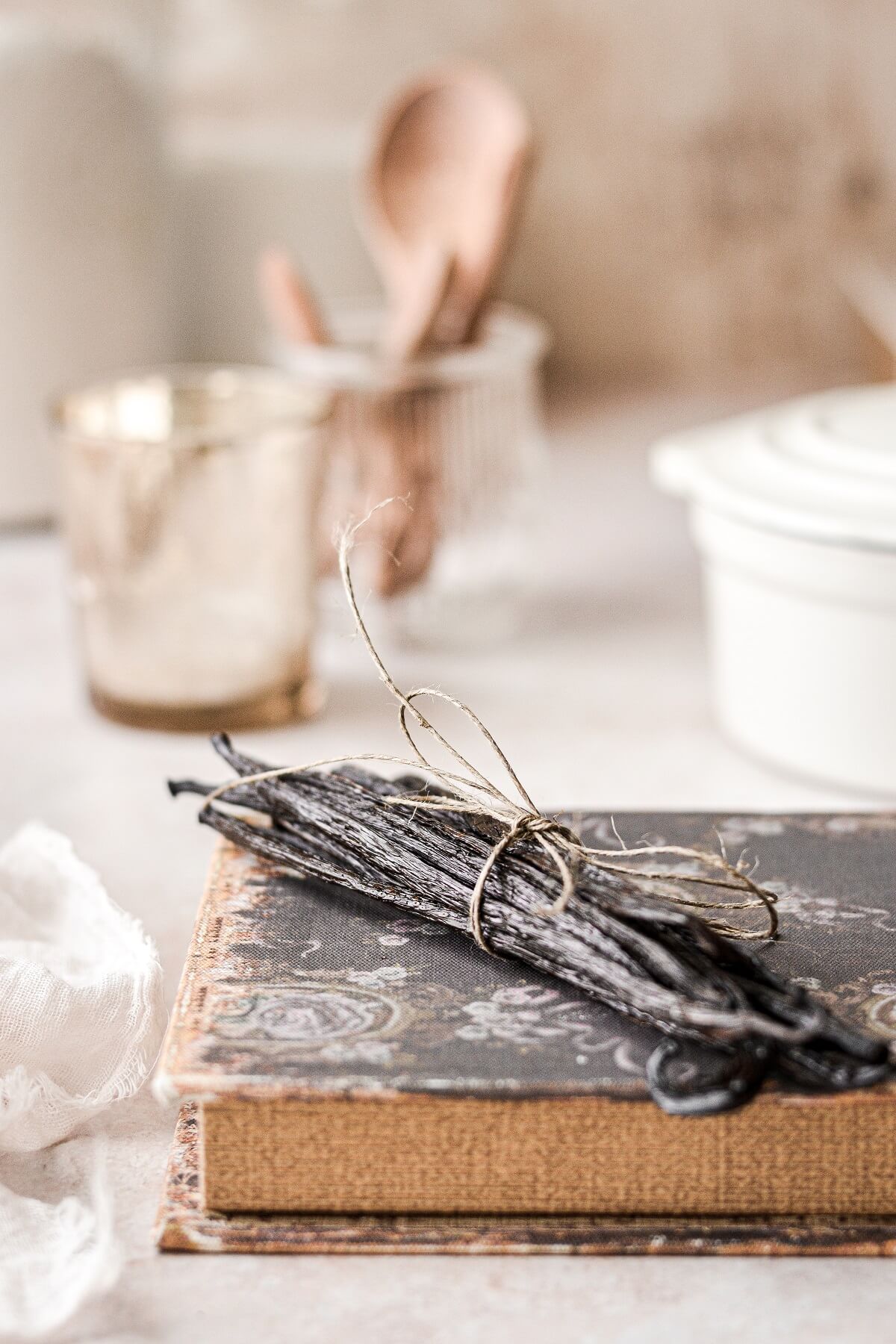
TIP: Be sure to check out my post on How to Make Homemade Vanilla Extract.
Types of Vanilla to Use in Baking
When flavoring your vanilla cake, you can use real vanilla beans, vanilla bean paste, or vanilla extract, and each has something a little different to offer.
Real Vanilla Beans
There’s nothing quite like the flavor and aroma of real vanilla beans. When you split open a vanilla bean and scrape out the seeds, the scent is intoxicating. In my vanilla cake recipe, I rub the vanilla bean seeds into the sugar before mixing up the cake batter, which infuses the sugar with as much vanilla flavor as possible.
I’ve been buying Tahitian vanilla beans online, and they are actually quite affordable at the moment, much more so than what you’d find at your local grocery store or spice shop. The Grade A Tahitian Vanilla Beans will be bigger and plumper, with more seeds inside. Grade B Tahitian Vanilla Beans won’t be quite as big and plump, but are still quite decent for the price.
Vanilla bean isn’t just for cakes, either. I use it in homemade ice cream, custards and cream pies, and the black specks of vanilla bean look just beautiful. After scraping out the seeds, there are a few ways you can use up the empty pod, but definitely don’t throw it away!
- Steep the scraped vanilla beans in vodka to make your own vanilla extract. I’d recommend about 8-10 beans inside of a pint jar of vodka. You’ll need to let it steep for at least 8 weeks, but 6 months will make it even more flavorful.
- Place the bean in a canister of sugar to infuse the sugar with vanilla flavor. Or place it in a bottle of vanilla extract so any trace amounts of vanilla seeds can add extra flavor to the extract.
- Dry the bean, then grind it into a vanilla powder. This is my favorite use, and what I always do with my scraped vanilla pods. I’ll add the ground vanilla powder right into cake batter, or sprinkle it on top of baked goods for a wonderful vanilla flavor.
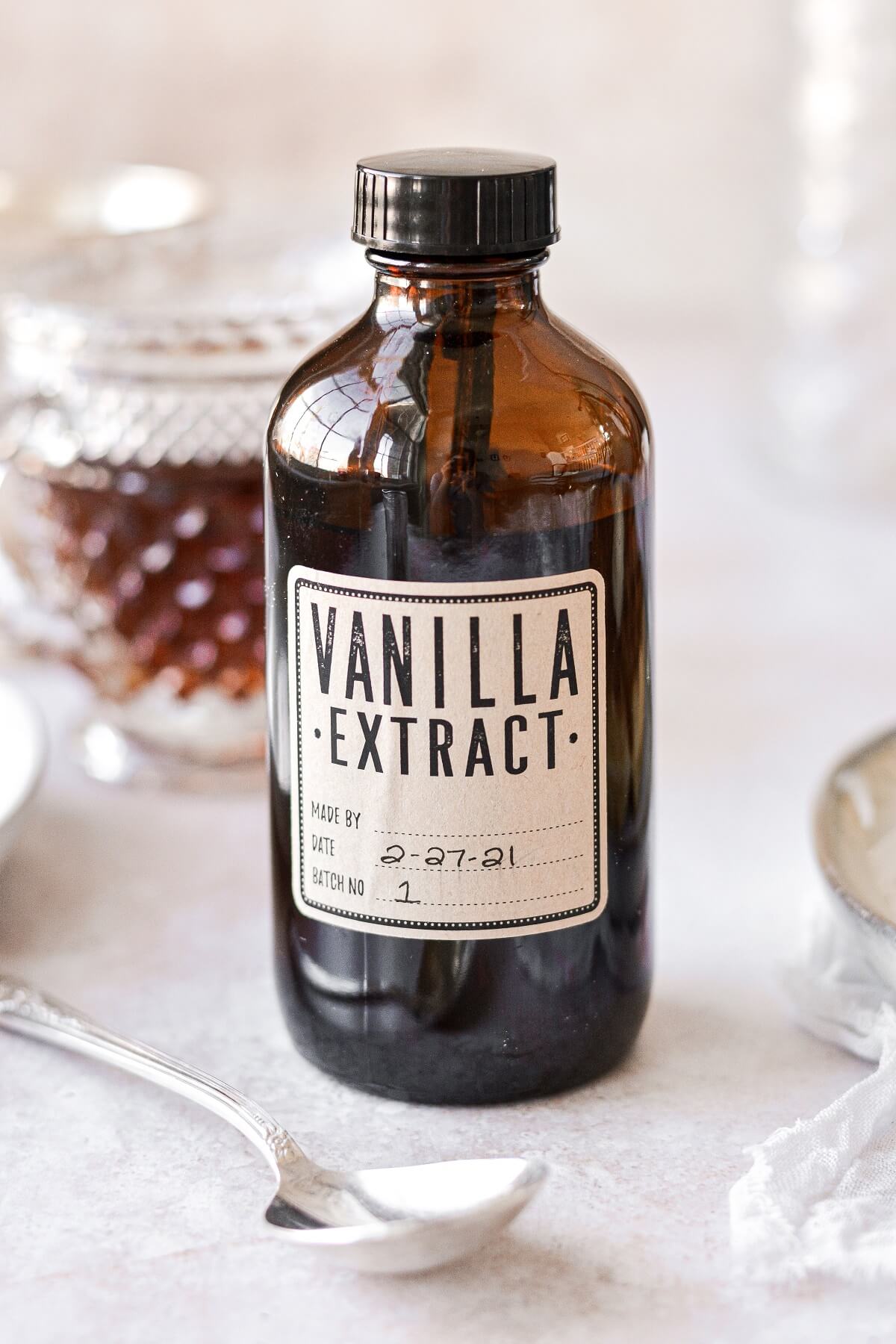
Vanilla Bean Paste
Vanilla bean paste is a rich, thick paste that contains a blend of scraped vanilla bean seeds and vanilla extract, as well as sugar, water and thickening ingredients. It’s a great option when you want to add real specks of vanilla bean to your baked goods, but don’t want to bother with using vanilla beans.
Pure Vanilla Extract
Vanilla extract is the most affordable type of vanilla. Some extracts are made from whole beans, while others are made from the pods after the specks are removed. The vanilla is macerated with alcohol and water, infusing its flavor into the liquid and stretching it to make it last longer. Be sure to look for the words “real” and “pure” on bottles of vanilla extract. Imitation vanilla extracts or vanillin has an inferior flavor to the real thing.
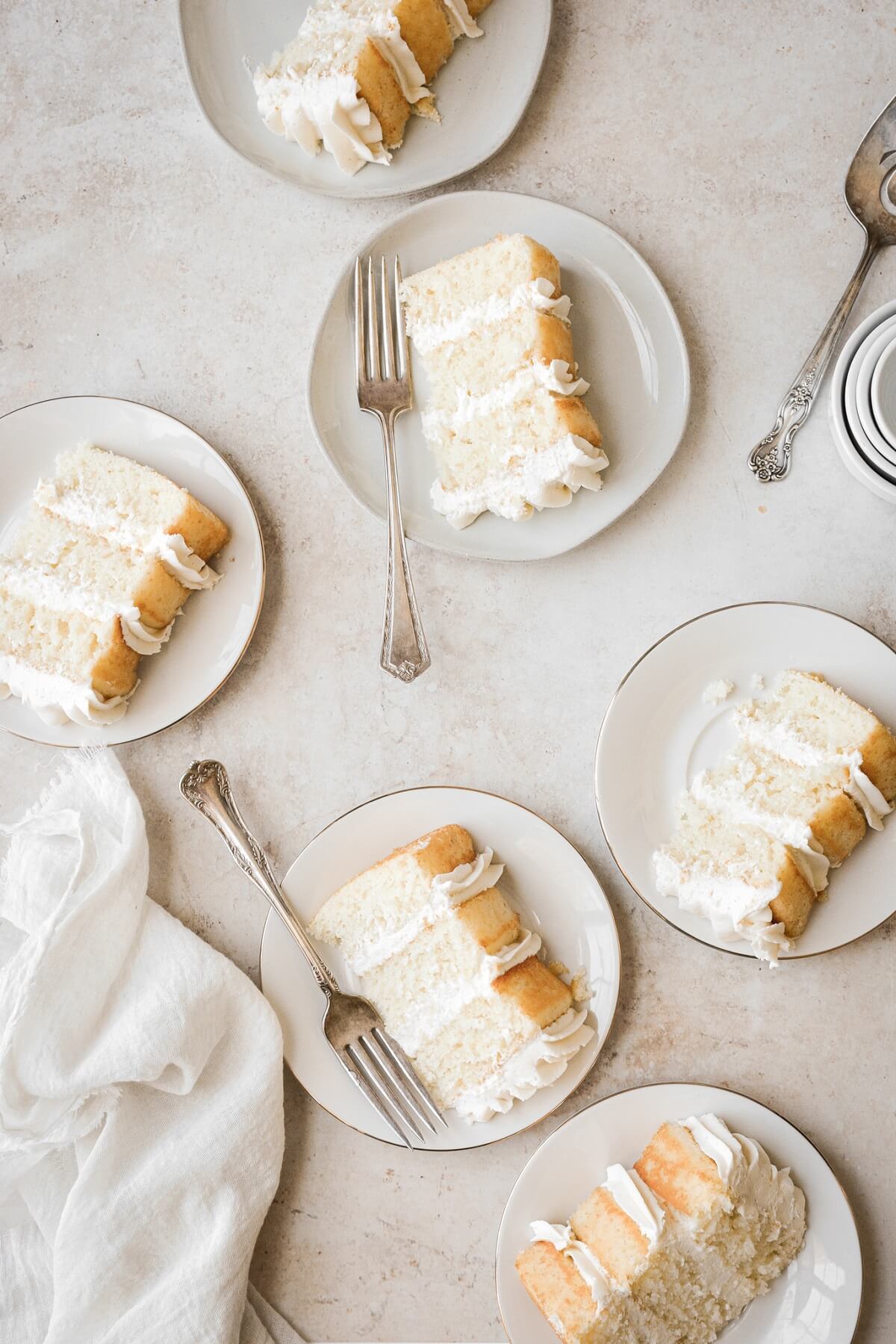
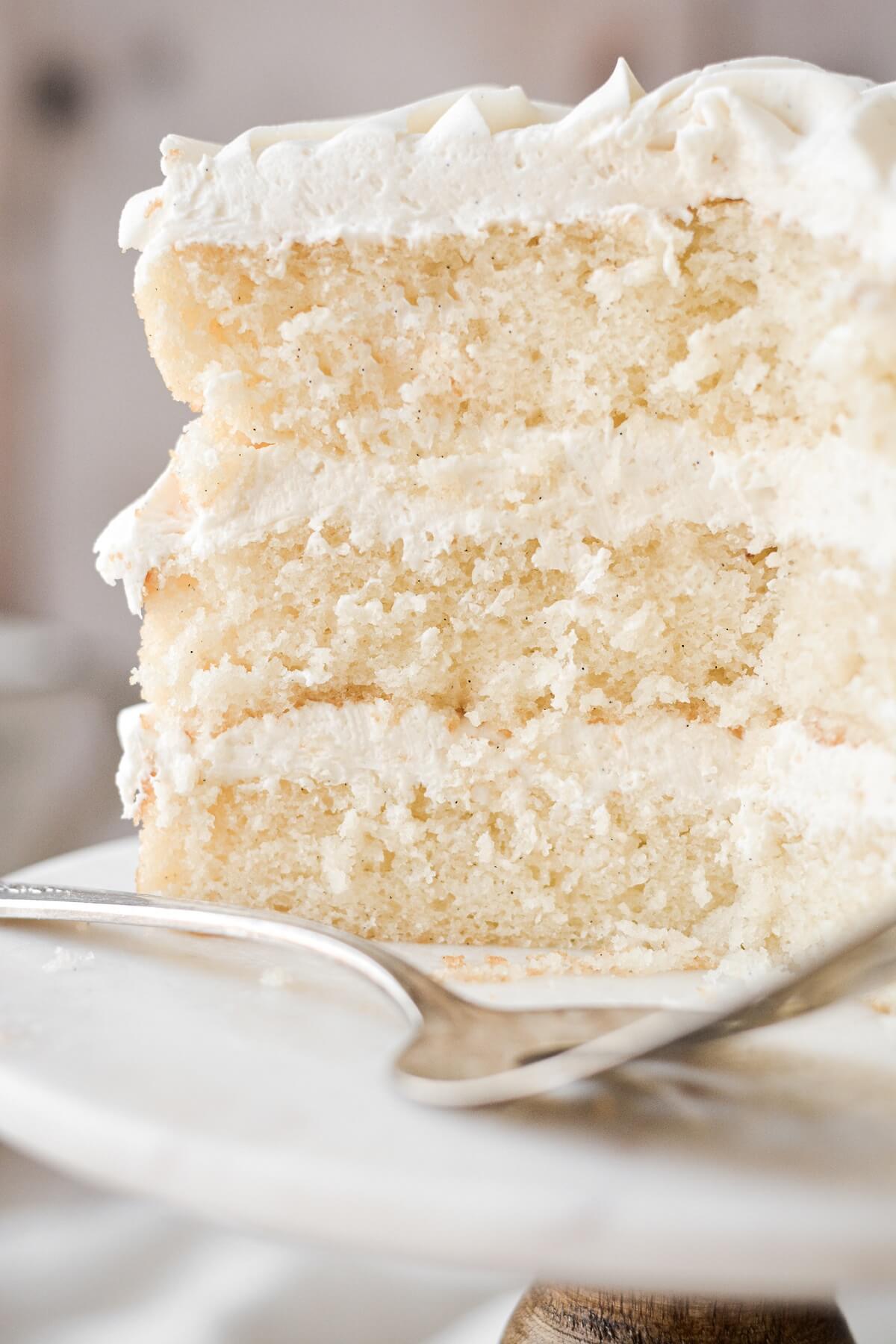
See the recipe card at the end of the post for the full ingredients list and instructions.
Ingredients
Cake
- Granulated Sugar. Adds sweetness and moisture to cakes. With high altitude baking, too much sugar can lead to a gummy texture in your cakes, so the sugar has to be perfectly balanced with the other ingredients.
- Vanilla Bean. Adds incredible flavor, especially when you rub the seeds into the sugar.
- Vanilla Extract. I use a combination of both vanilla bean seeds and vanilla extract. You can use both, or just one of them, whichever you like.
- Cake Flour. Cake flour makes a very soft, light and fluffy vanilla cake, as it contains a lower percentage of protein than all-purpose flour.
- Baking Powder. Leavens the cake, making it rise.
- Coarse Kosher Salt. Balances the sweetness.
- Eggs + Egg Whites. I use 2 eggs, plus 2 egg whites, in my vanilla cake, which adds structure and richness, while the extra whites make it nice and fluffy. Save the leftover 2 egg yolks for another use.
- Buttermilk. Adds richness and acidity for a light, fluffy, tender cake crumb.
- Melted Butter + Vegetable Oil. A combination of both butter and oil gives this vanilla cake the best flavor as well as a soft, moist texture.
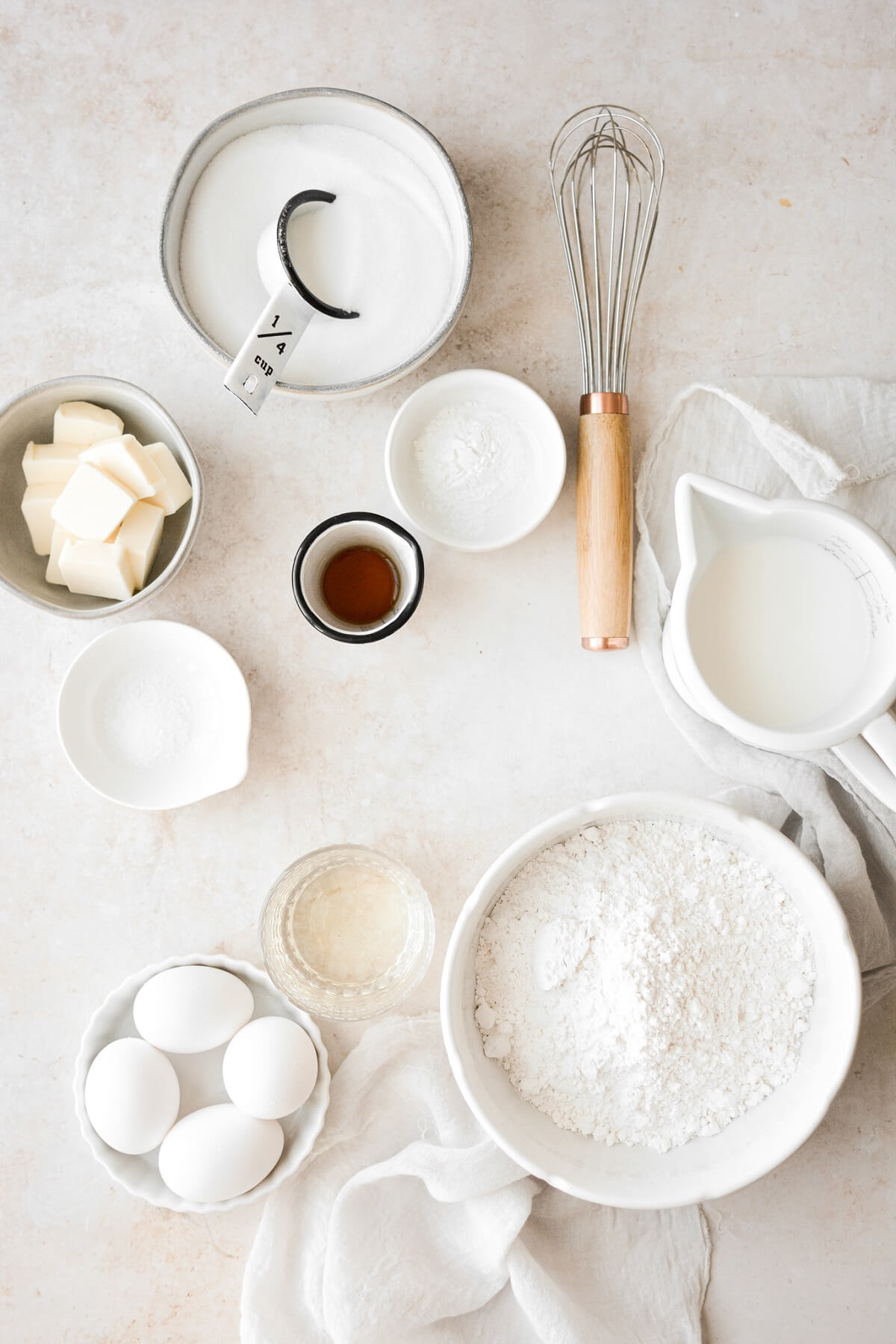
Buttercream
- Butter. I use unsalted butter and then add a pinch of salt. But if you prefer to use salted butter, that’s totally fine. Just omit the extra salt in the recipe.
- Vanilla. You can scrape a vanilla bean and use the seeds, or use vanilla bean paste or just vanilla extract.
- Powdered Sugar. Sweetens and thickens the buttercream.
- Meringue Powder. Adds stability and improves the texture.
- Salt. Balances the sweetness.
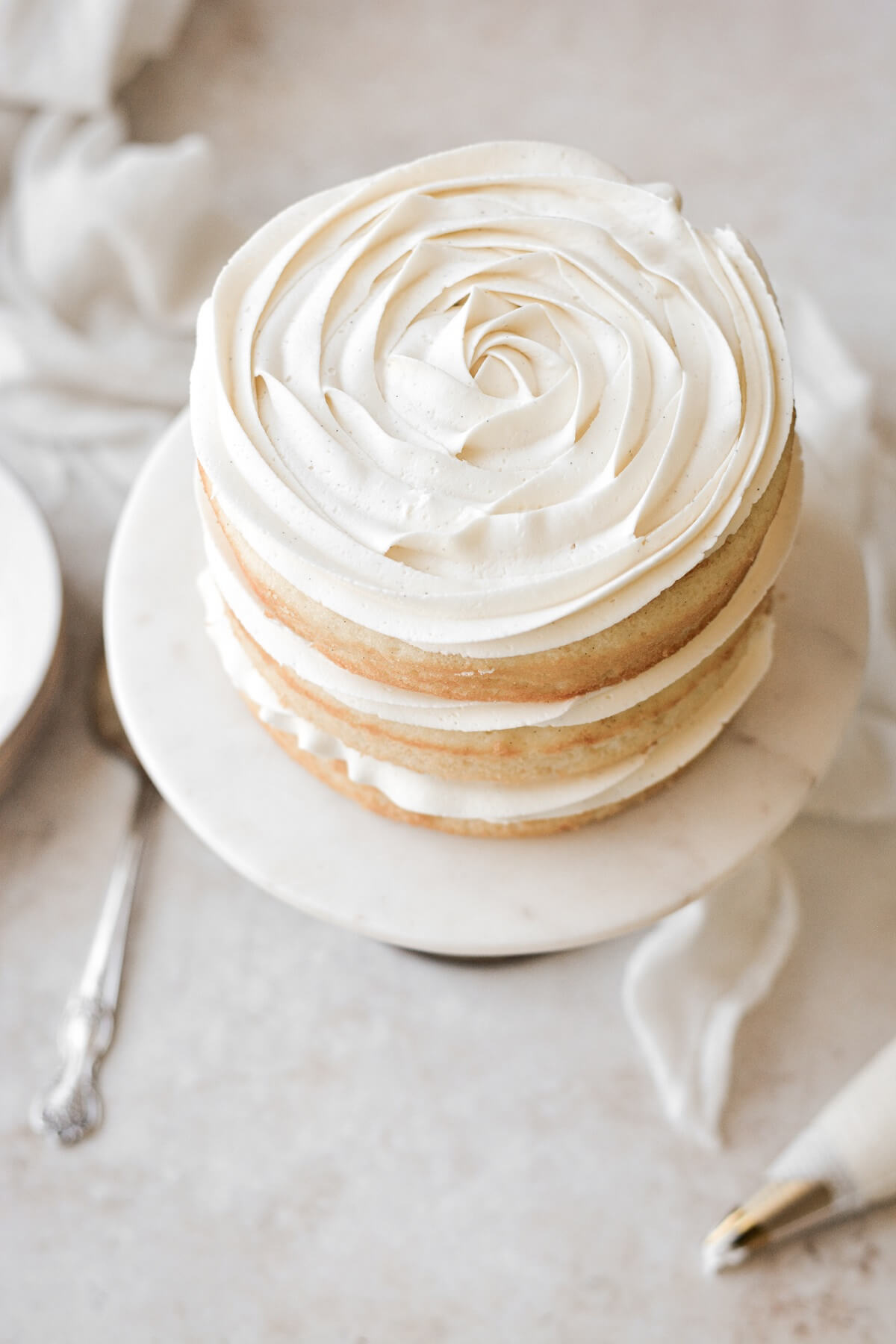
Instructions
Rub the Vanilla Bean Seeds into the Sugar.
- Preheat the oven to 350F, position a rack in the center of the oven, and spray the bottoms of three 8-inch cake pans with non-stick spray.
- In a large bowl, measure out the sugar. Scrape the seeds from the vanilla bean pod and use your fingers to rub the seeds into the sugar until very fragrant and the seeds are evenly dispersed throughout the sugar.
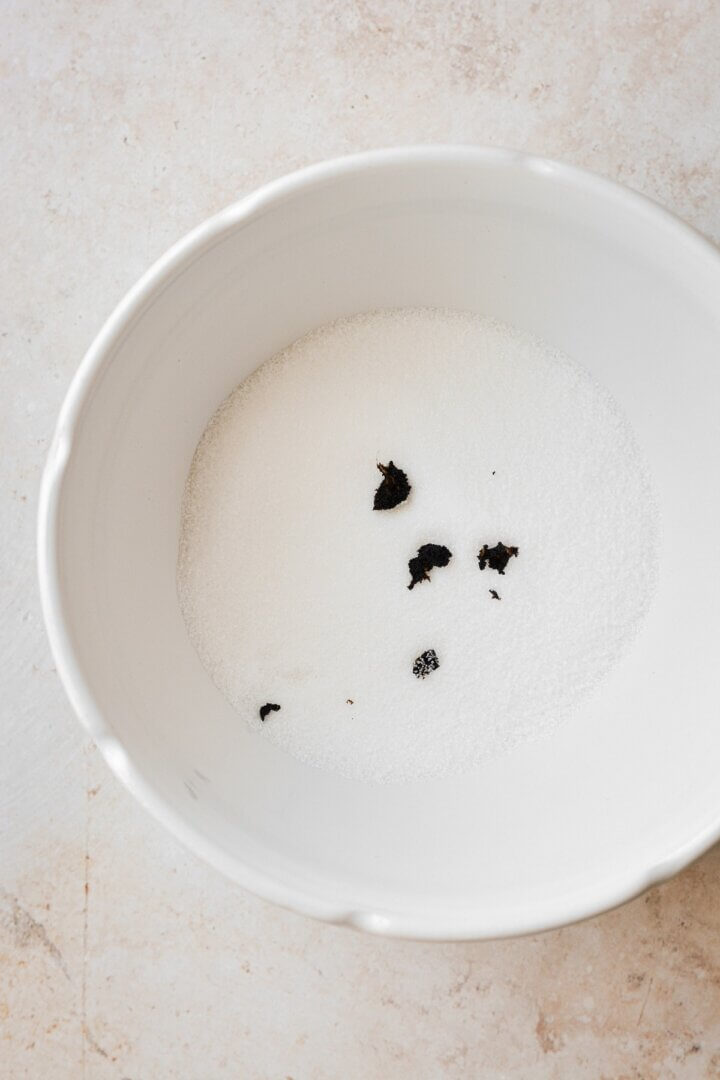
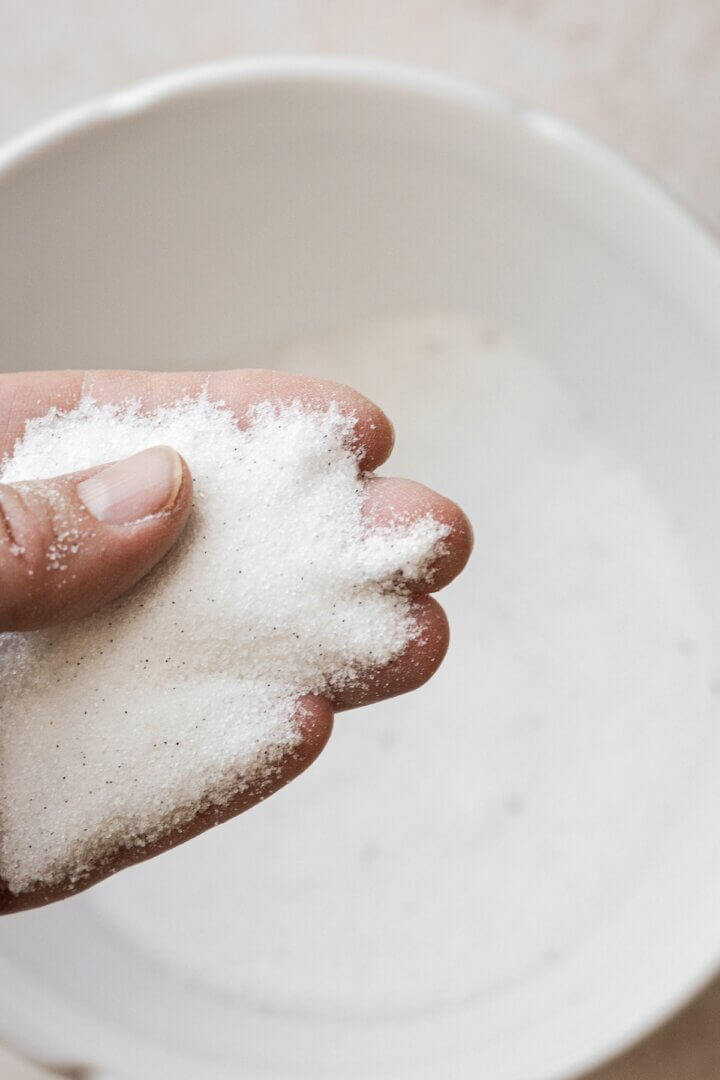
Sift Together the Dry Ingredients.
- Set a fine mesh sifter over the bowl of sugar, and sift in the cake flour, baking powder and salt.
- Use a whisk to combine the dry ingredients well.
Whisk in the Liquid Ingredients.
- In another large bowl, whisk together the eggs, egg whites, buttermilk, melted butter, oil and vanilla extract until smooth.
- Add the dry ingredients to the wet, and whisk until combined, about 10-15 seconds. A few lumps in the batter are okay; take care not to over mix.
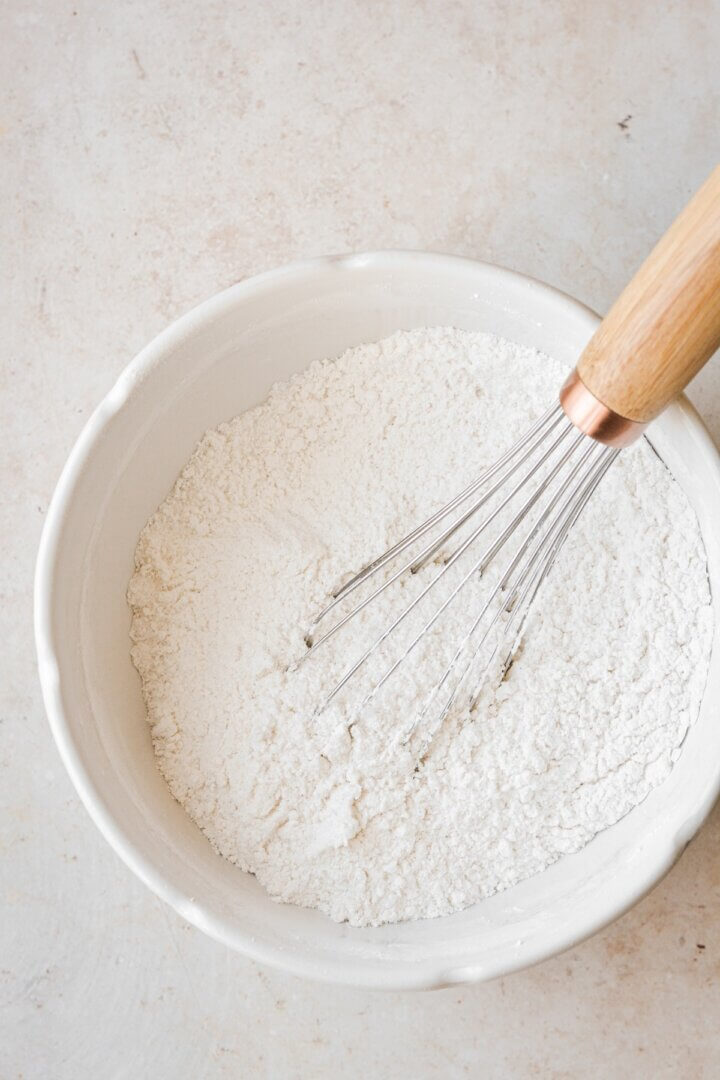
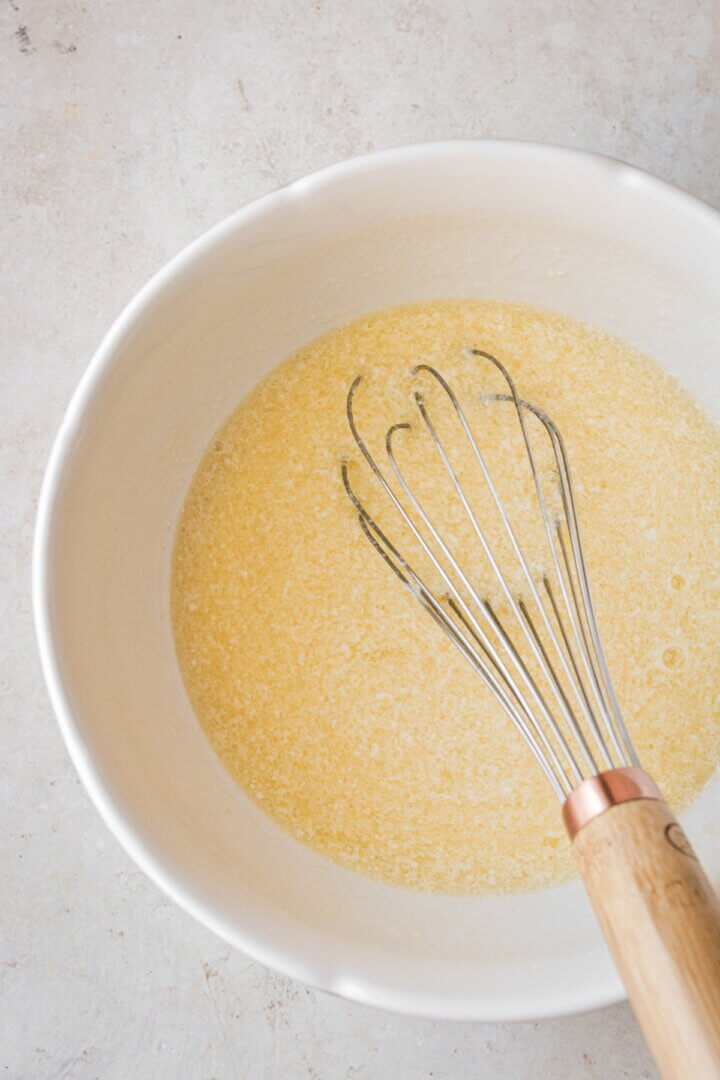

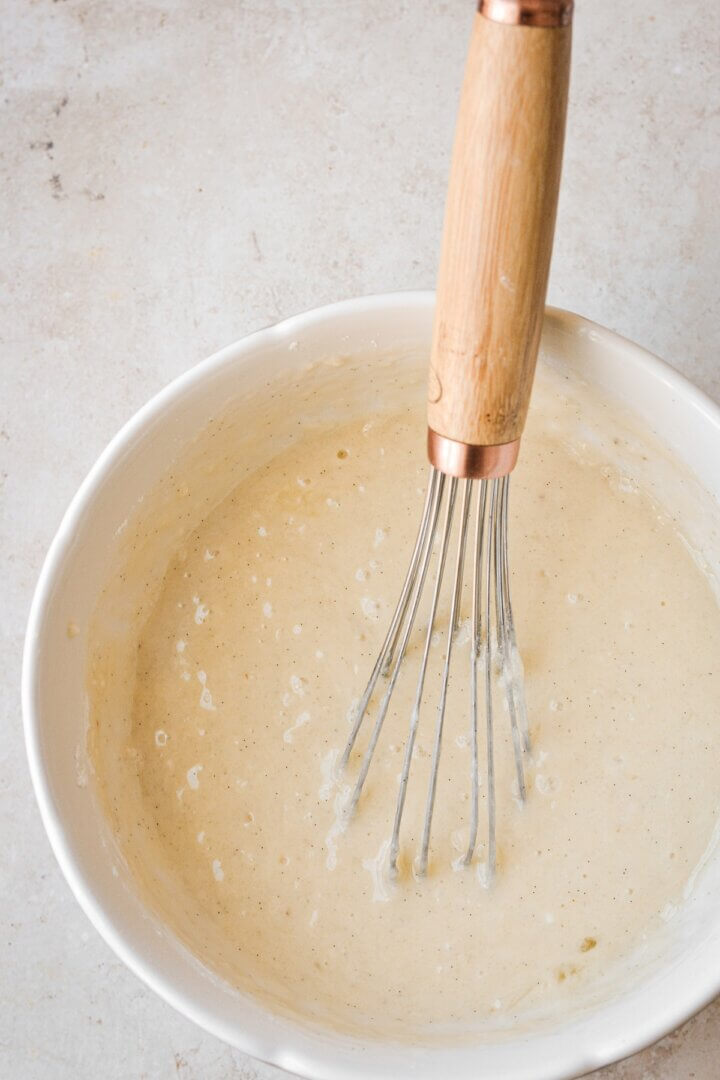
Bake and Cool.
- Divide the batter between the cake pans. Tap a few times against the counter to pop any large air bubbles.
- Bake the cakes for about 21-25 minutes, or until a cake tester or a toothpick comes out clean, and the tops spring back when lightly touched.
- Set the pans on a wire rack, cover them loosely with a clean kitchen towel, and cool completely before frosting. When ready to frost and assemble the cake, remove the cakes from the pans.
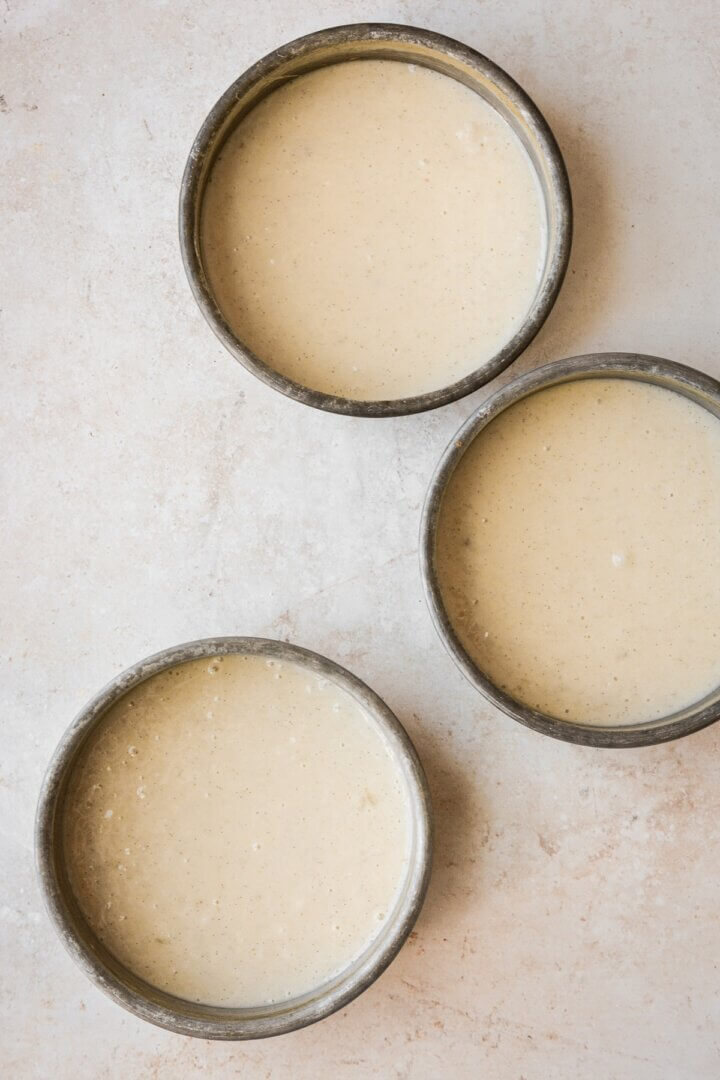
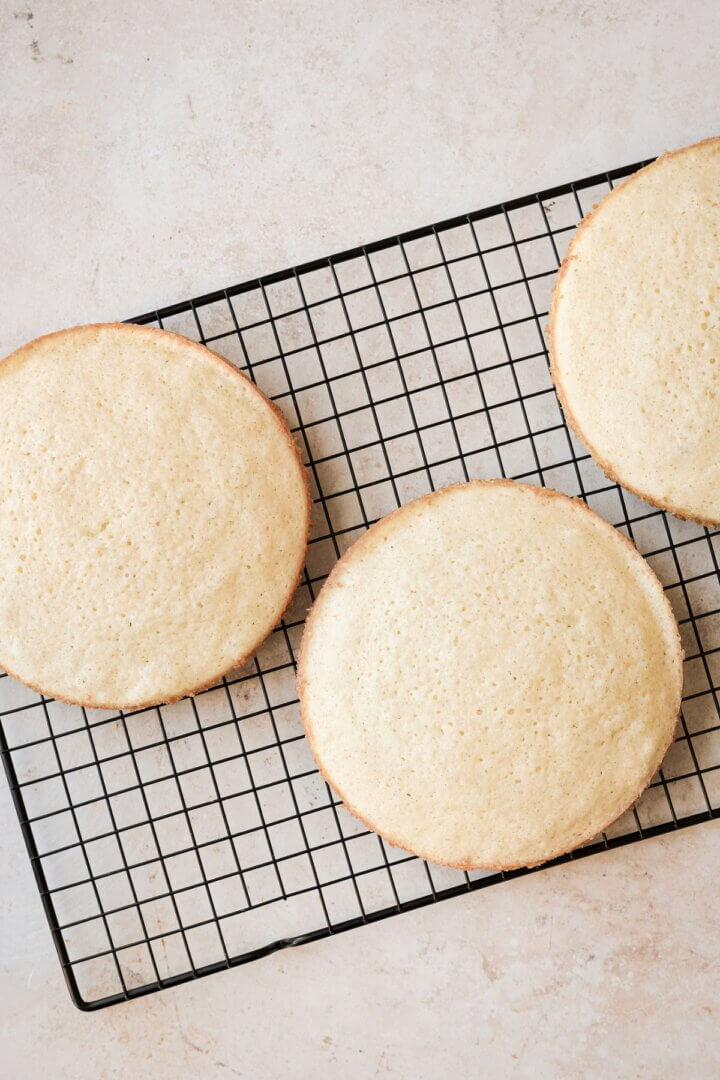
Make the Buttercream.
- In the bowl of your stand mixer fitted with the whisk attachment, beat the butter and vanilla bean seeds for 1 minute until smooth.
- With the mixer running on low, add the powdered sugar by spoonfuls, the meringue powder and the salt, mixing until thick and combined.
- Add the vanilla and the milk; increase speed to medium and whip for 4-5 minutes, scraping the bowl down several times, until light and fluffy.
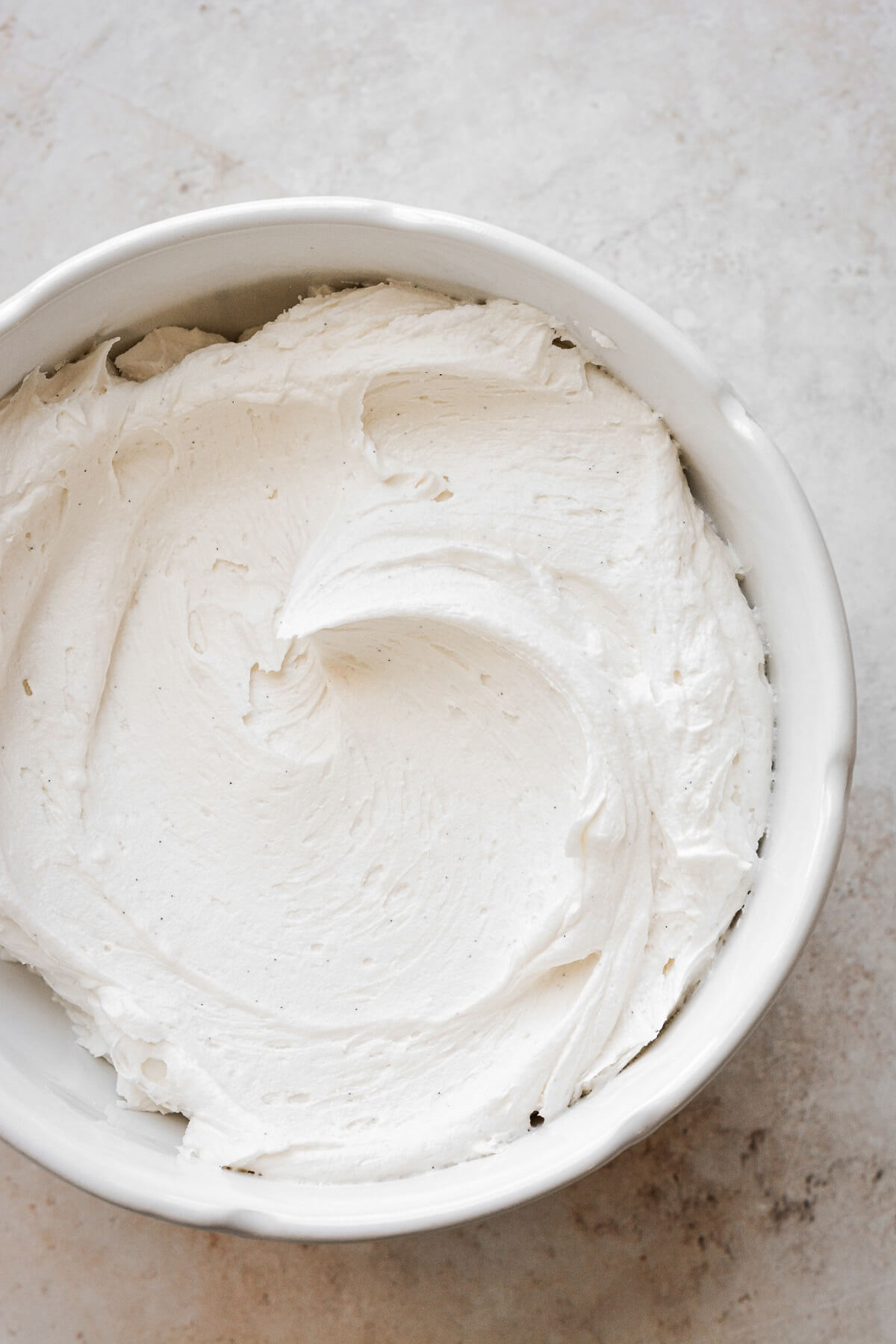
- Fill and frost the cooled cakes with the buttercream.
- For the naked cake pictured in today’s post, fit a piping bag with tip 1M and fill with buttercream. Place one layer of cake on your cake stand or cake board. Starting at the center of the cake, pipe a swirl from the center to the outer edge, to form a large rosette. Place another cake layer on top, and repeat. You’ll have leftover buttercream if you leave the sides unfrosted, which you can freeze in a freezer bag for another baking project.
- Note that naked cakes can dry out faster, since they aren’t covered in buttercream to keep the sides moist. So be sure to keep the cake tightly covered in an airtight container until ready to serve.
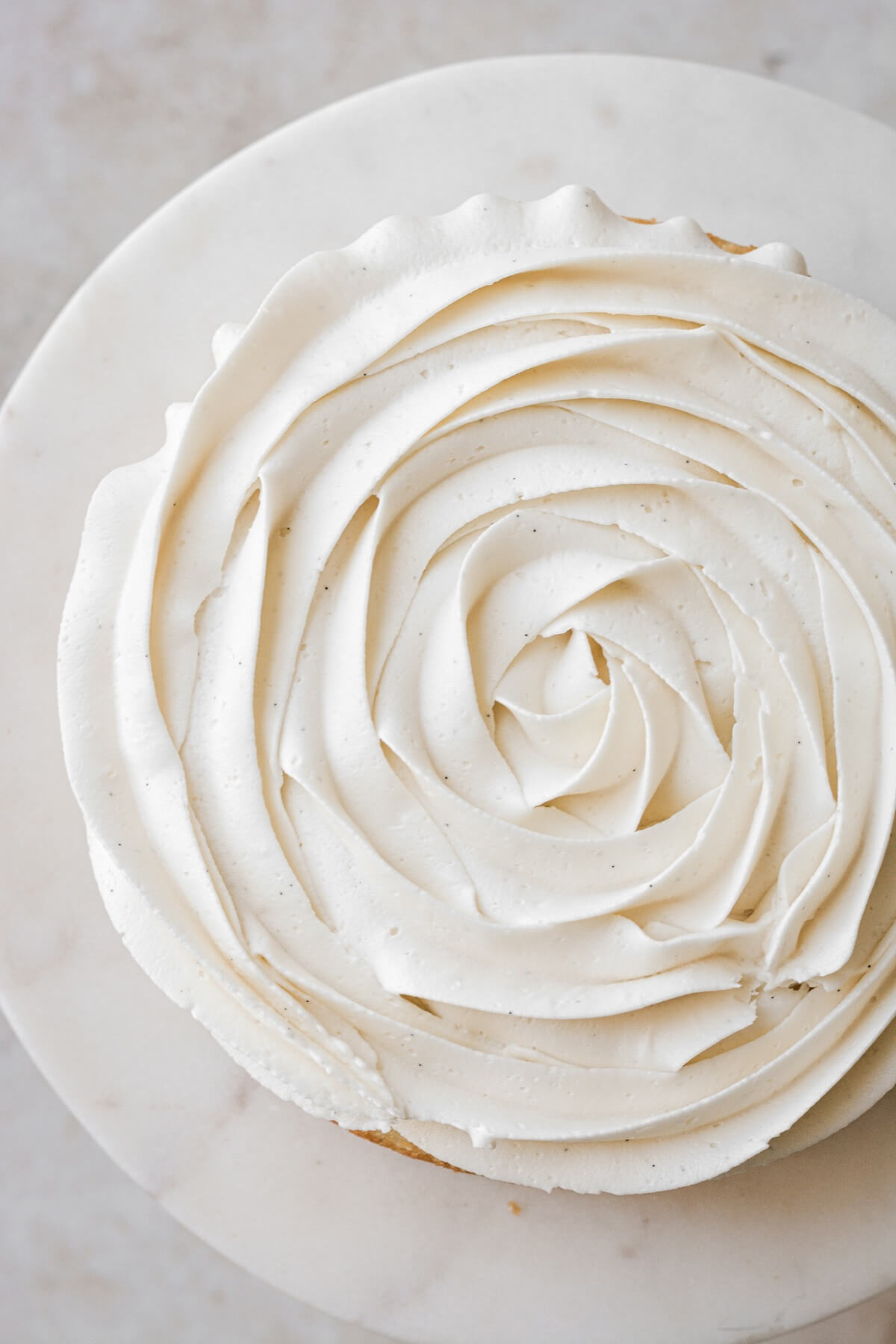
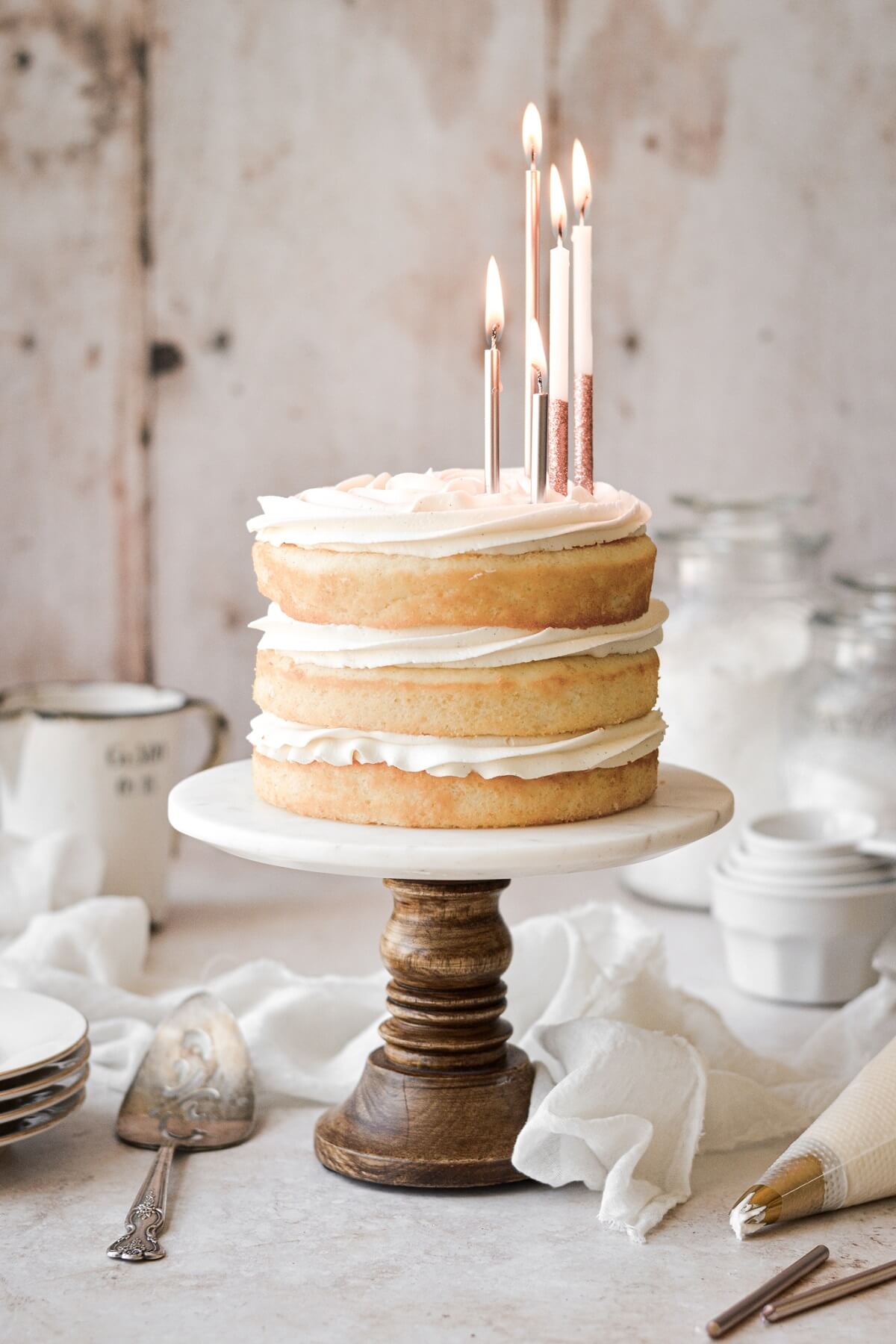
Recipe Variations
Sheet Cake. Make the full cake recipe in a 9×13 inch baking pan, or half the cake recipe in one 8-inch square baking pan.
Eggless Vanilla Cake. For a high altitude eggless vanilla cake, you only need to make a few minor adjustments. Eggs are expensive these days, so I wanted to create an eggless variation of this cake that’s just as perfect as the original recipe. Whether the price of eggs is a factor, or you’re baking for someone with an egg allergy, or you’ve simply run out of eggs, it’s great to have other options. The eggless cake is just as soft, moist and fluffy, and baked absolutely perfectly when I tested half the recipe in an 8 inch square pan. It was totally delicious frosted with chocolate buttercream.
- Replace the 2 whole eggs with 2 tablespoons corn starch and 6 tablespoons water (add the corn starch to the dry ingredients and the water to the wet ingredients).
- Replace the 2 egg whites with 5 tablespoons sour cream (added to the wet ingredients).
- Increase the baking powder from 3 teaspoons to 3 1/2 teaspoons.
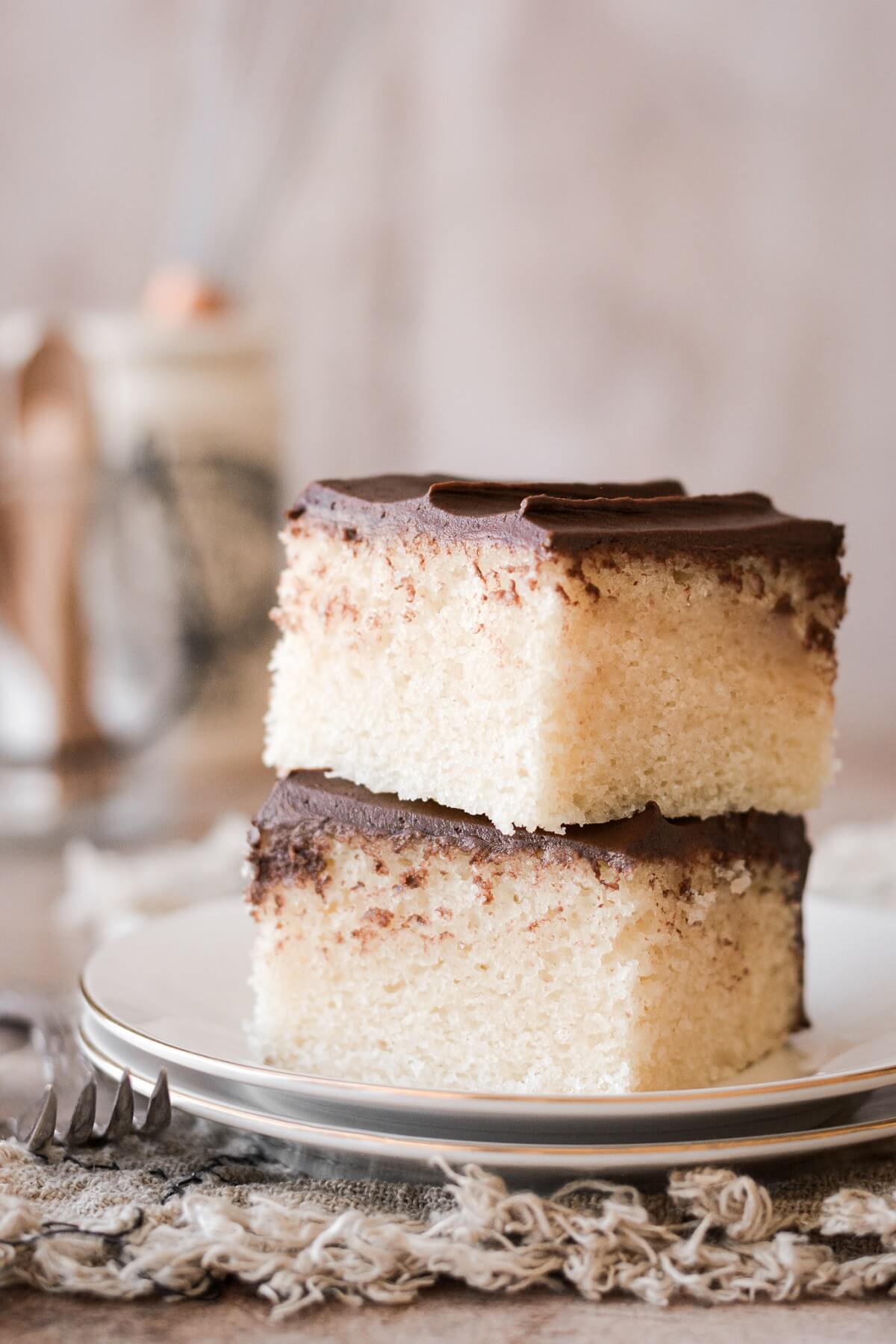
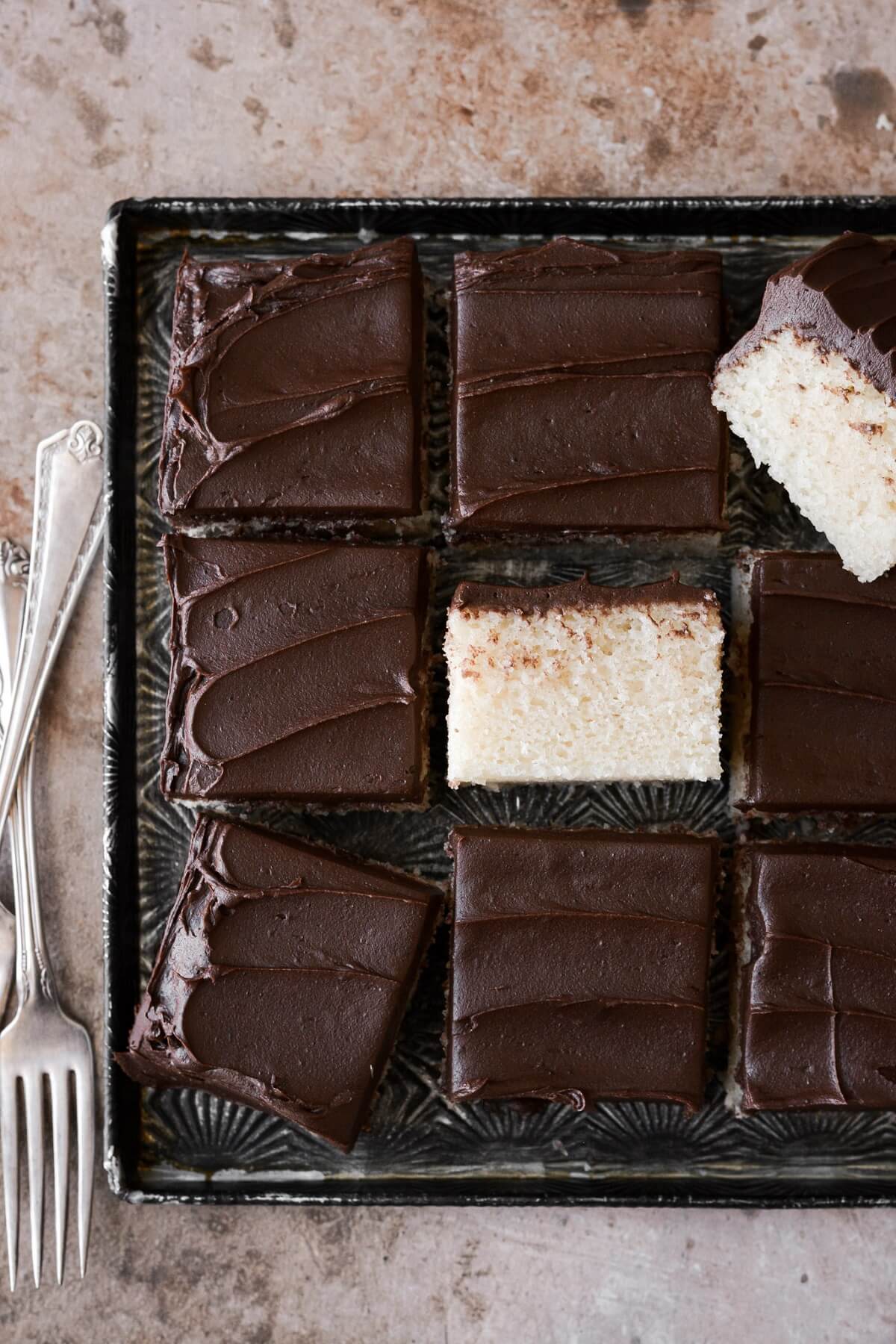
Be sure to read all of my BAKING FAQs where I discuss ingredients, substitutions and common questions with cake making, so that you can be successful in your own baking! I also suggest reading these comprehensive posts on making Perfect American Buttercream, How to Stack, Fill, Crumb Coat and Frost Layer Cakes and How to Use Piping Bags.
Frequently Asked Questions
What should I use if I don’t have cake flour?
If you can’t find cake flour at your local grocery store or Walmart, you can also buy cake flour online. In a pinch, you can make your own cake flour. Measure out 1 cup of all-purpose flour using the spoon and sweep method. Remove 2 tablespoons of flour, and replace with 2 tablespoons of corn starch. Whisk together until thoroughly combined.
Can I make this recipe with gluten free flour?
Yes, I’ve had feedback from people who have made this recipe successfully with gluten free flour. I’d recommend using your favorite measure-for-measure gluten free flour, although the cake will likely have a slightly coarser texture.
What can I substitute for the buttermilk?
While I prefer whole buttermilk, I’ll also use lowfat buttermilk if it’s the only thing available at my grocery store. The next best thing is to make your own sour milk by stirring together 1 1/2 tbsp white distilled vinegar or lemon juice with 1 1/2 cups whole milk. Let sit for 15 minutes to curdle before mixing your cake batter.
Why did you change this recipe from the original vanilla cake recipe on your blog?
I felt like the original cake was too oily, and didn’t bake consistently for high altitude. See the next section below for details on my recipe updates.
Can I make the cake ahead of time and freeze it?
Yes, after baking and cooling the cakes, wrap each layer individually in plastic wrap and freeze for 3-6 months until you’re ready to frost your cake. You can also freeze the fully assembled and frosted cake in an airtight container for up to 3 months.
How long will this cake stay moist?
If you keep it in an airtight container, it will stay moist for days and days! If it lasts that long.
How should I store the leftover cake?
Store leftover vanilla cake in an airtight container or cake carrier at room temperature for up to 3-5 days.
Can I bake this cake recipe as cupcakes instead?
I have a slightly modified version of this recipe to make vanilla cupcakes.
Do I need to use 8-inch cake pans, or can I use 9-inch cake pans?
I love my 8-inch cake pans, since they make tall, pretty cakes. You can certainly bake this recipe in 9-inch pans, though, and your assembled cake will be a little wider and shorter.
Will this recipe work as a sheet cake?
This recipe will certainly work as a sheet cake. Bake the batter in a greased 9×13 pan, and bake for a little longer, watching the center for doneness.
Can I cut this recipe in half?
Yes, you can easily halve this vanilla cake recipe, and bake the batter in three 6-inch pans for about 18-20 minutes.
Can I make this recipe even if I don’t live at high altitude?
Yes, many people who are not at high altitude have tried and loved my vanilla cake recipe. If you’re at sea level, you may need to make a few slight modifications, such as reducing the flour by 2-4 tablespoons, and increasing the baking powder from 3 tsp to 4 tsp. I live in Denver, which has an altitude of 5,280 feet, so if you live significantly higher than that (more than 1,000 feet higher), you might need to make a few minor adjustments, such as increasing the flour a bit more, and decreasing the baking powder a little. Please read this post on guidelines for adjusting cake recipes for various altitudes.
What flavor of buttercream should I frost a vanilla cake with?
In my recipe card below, I’ve included my recipe for vanilla buttercream. But honestly, you can use absolutely any flavor of buttercream and filling that you like – everything is good with vanilla! See my comprehensive post on Perfect American Buttercream to read all about how I make my buttercream, as well as ideas for other flavors.
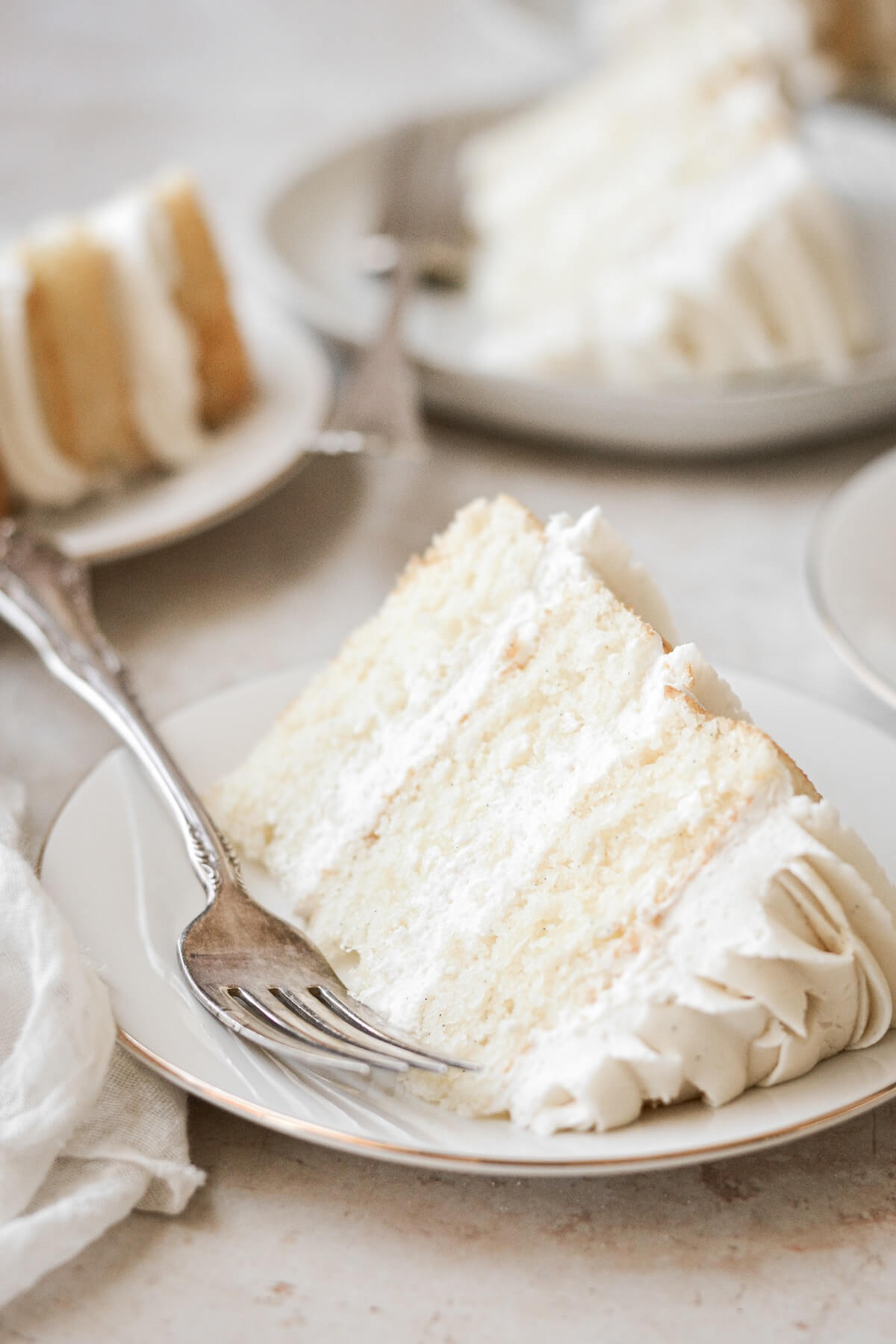
Recipe Updates
I originally published this vanilla cake recipe almost 6 years ago, so many of you have tried and loved it over the years. However, I felt there were a few areas that needed improving, especially for high altitude bakers, to ensure a delicious and perfect vanilla cake. If you still love and prefer the original recipe, though, you can find the original ingredients list in the notes section of the recipe card at the bottom of this post.
- Cake flour for a fluffier cake crumb. First, I swapped the all-purpose flour for cake flour, which makes a lighter, fluffier, more tender cake crumb. I also increased the amount of cake flour, as the flour to sugar to leavening ratio seemed a little off. The increase in flour stabilizes the batter for a much better rise.
- Butter + oil for better flavor and less oily texture. In my original recipe, I used a whole cup of vegetable oil. Over time, I really felt like that was far too much oil, and the flavor of the oil overwhelmed the flavor of the vanilla. For a much better flavor, but a cake that’s still very moist, I now use 1/2 cup melted butter + 1/2 cup vegetable oil.
- Using only baking powder. In my original recipe, I used both baking soda and baking powder. Baking soda is stronger than baking powder, and it seems to leaven this vanilla cake too aggressively, which can lead to a fallen center for high altitude bakers. To stabilize the leavening process, I now use only baking powder for a slower, steadier rise that ensures the cake won’t fall.
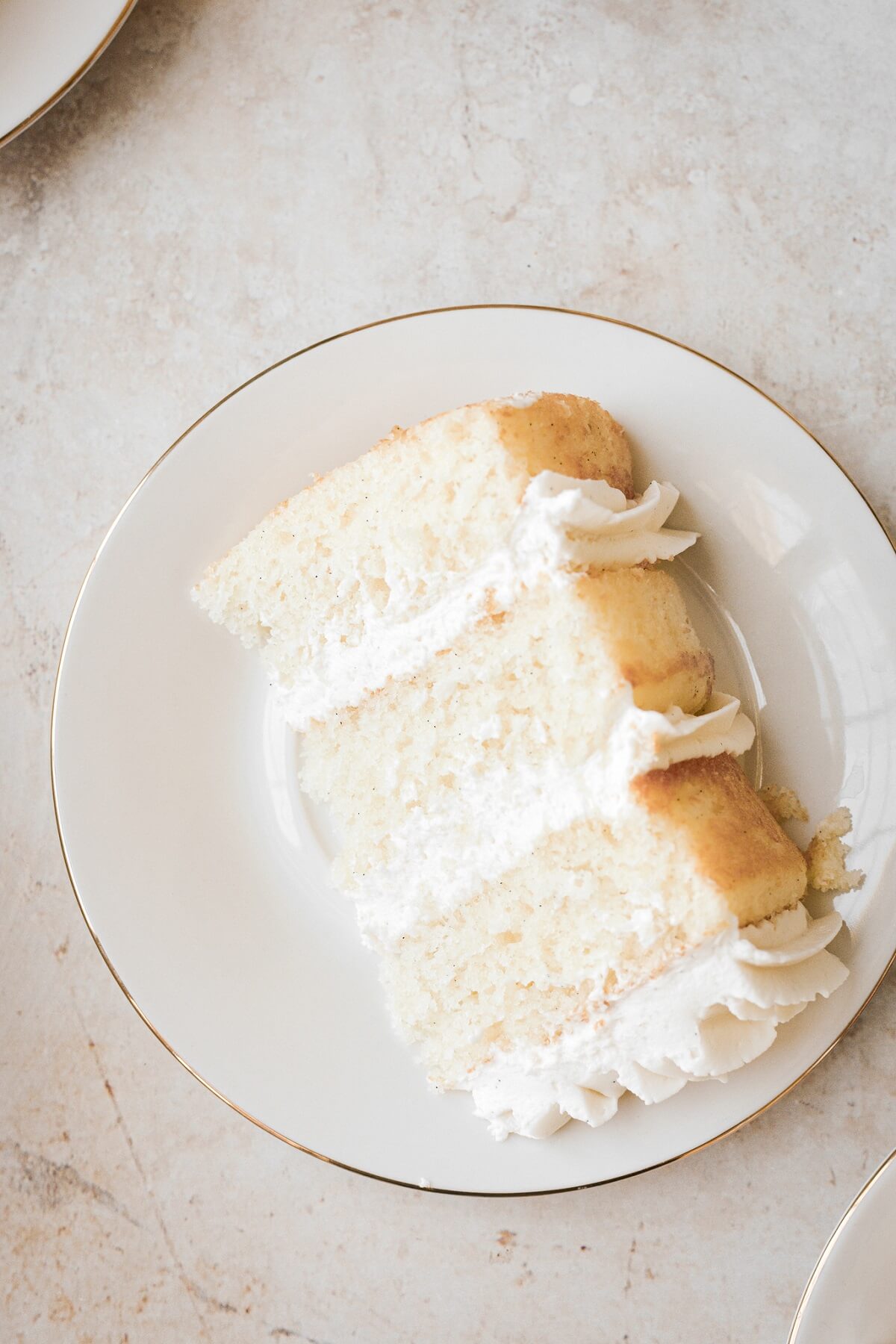
You Might Also Like
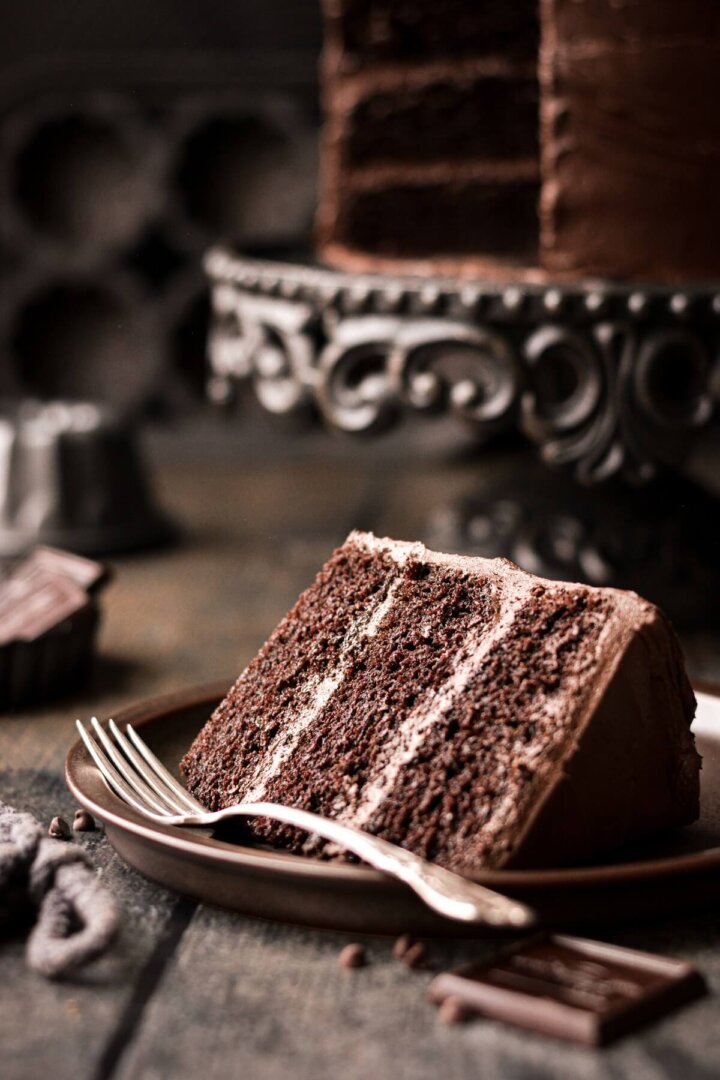
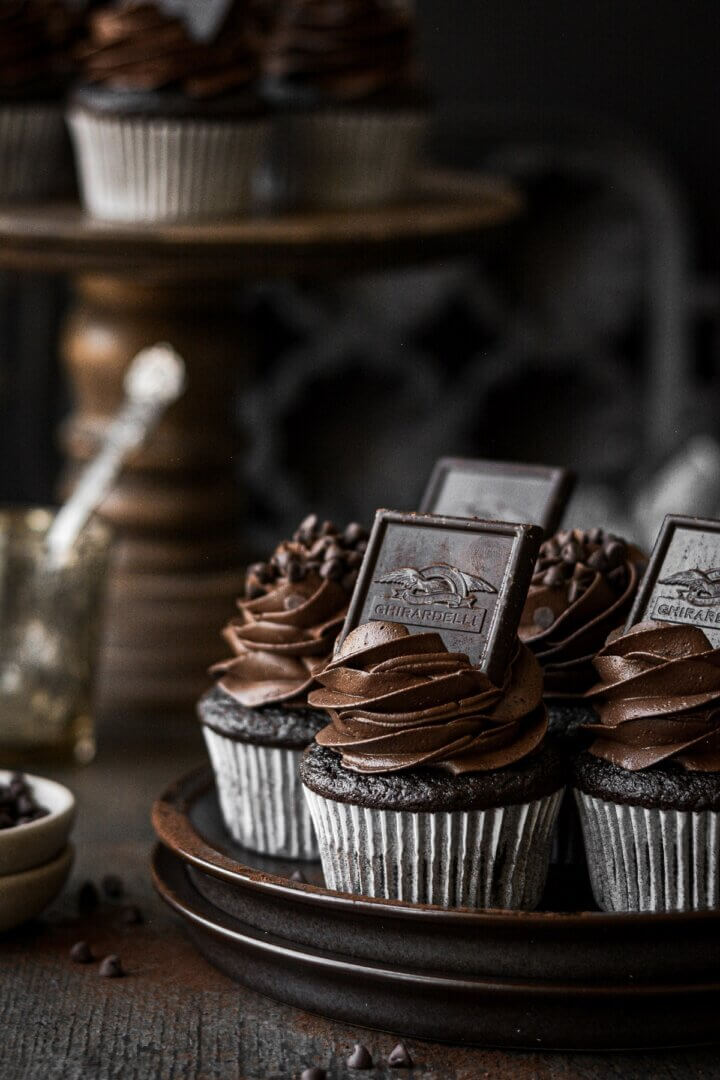
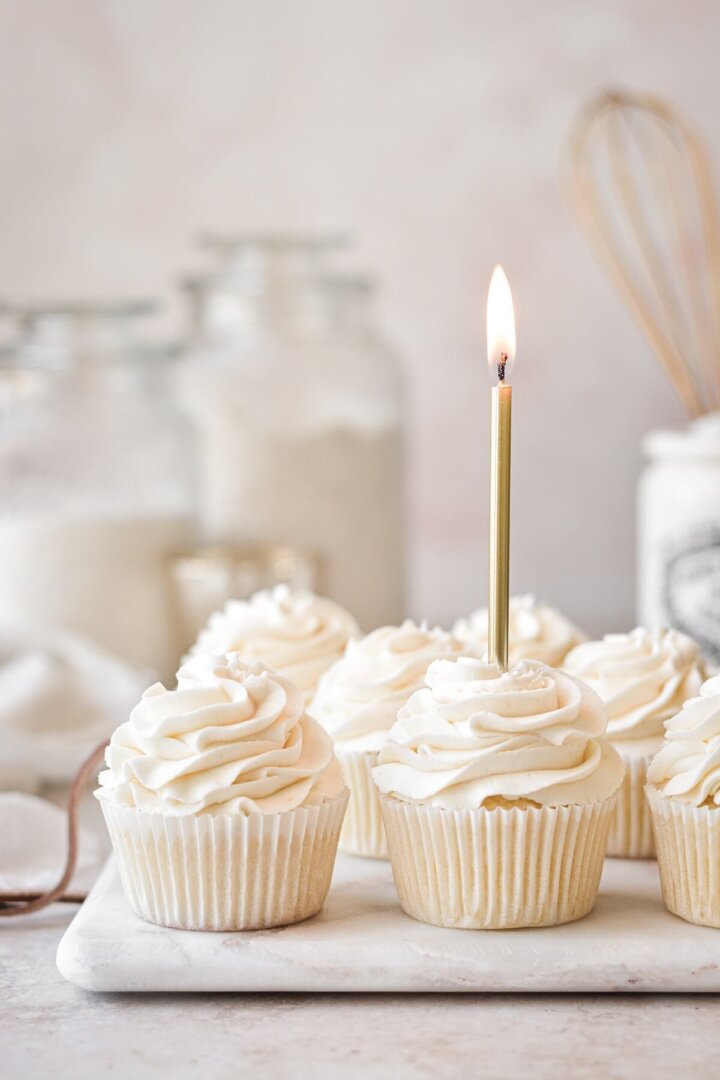
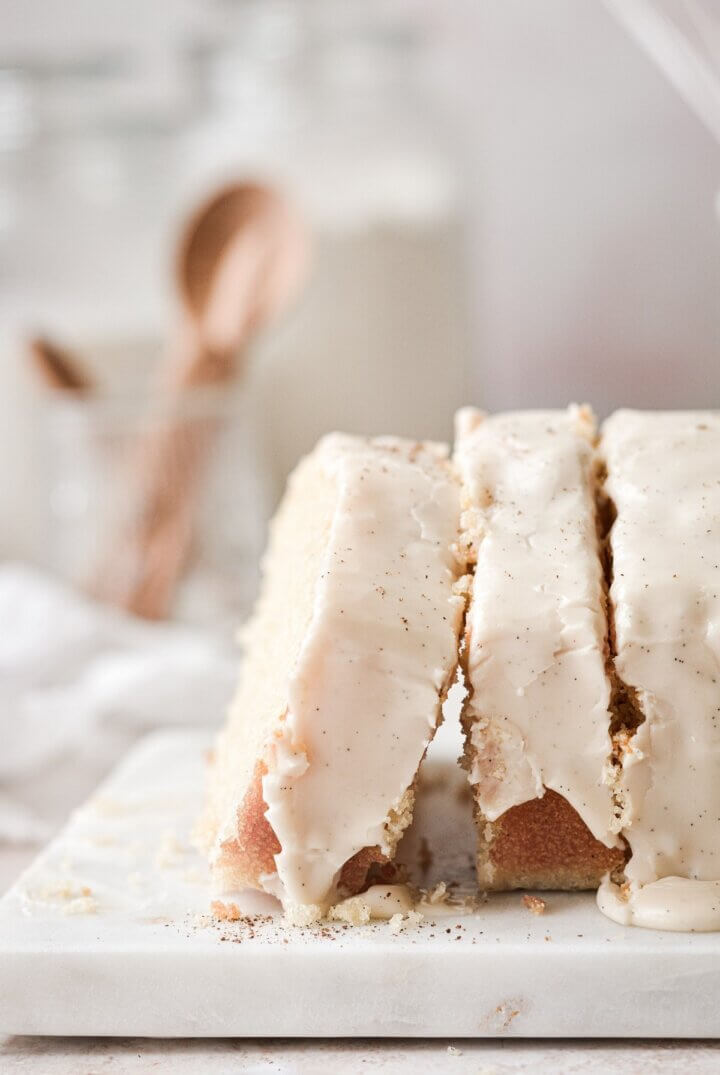
Please check out my Amazon Shop for a curated collection of some of my favorite cake pans from trusted brands, baking tools, ingredients, pretty things and fashion finds. I recommend products that I buy and use every day!
Did you love today’s recipe? Please rate the recipe and let me know in the comments what you thought! Also, be sure to follow Curly Girl Kitchen on Instagram, and tag me when you try one of my recipes so I can see all your delicious creations!
High Altitude Vanilla Cake
All recipes on Curly Girl Kitchen are developed for high altitude at 5,280 feet. See FAQs for adjusting to higher or lower elevations.
Equipment
- Stand Mixer with Paddle Attachment
Ingredients
Cake
- 1 ½ cups granulated sugar
- ½ vanilla bean, seeds scraped
- 3 ¼ cups cake flour, spooned and leveled, then sifted
- 3 tsp baking powder
- 1 tsp coarse Kosher salt (if using table salt, use half the amount)
- 2 large eggs, room temperature
- 2 large egg whites, room temperature
- 1 ½ cups whole buttermilk, room temperature
- ½ cup unsalted butter, melted, and then cooled for 10 minutes
- ½ cup vegetable oil
- 2 tsp vanilla extract
Buttercream
- 2 cups unsalted butter, softened to room temperature
- ½ vanilla bean, seeds scraped
- 4 cups powdered sugar
- 1 tbsp meringue powder (optional)
- ¼ tsp coarse Kosher salt (if using table salt, use half the amount)
- 2 tsp vanilla extract
- 2-4 tbsp milk or cream, only if needed for consistency
Instructions
Cake
- Preheat the oven to 350F, position a rack in the center of the oven, and spray the bottoms of three 8-inch cake pans with non-stick spray.
- In a large bowl, measure out the sugar. Scrape the seeds from the vanilla bean pod and use your fingers to rub the seeds into the sugar until very fragrant and the seeds are evenly dispersed throughout the sugar.
- Set a fine mesh sifter over the bowl of sugar, and sift in the cake flour, baking powder and salt. Use a whisk to combine the dry ingredients well.
- In another large bowl, whisk together the eggs, egg whites, buttermilk, melted butter, oil and vanilla extract until smooth.
- Add the dry ingredients to the wet, and whisk until combined, about 10-15 seconds. A few lumps in the batter are okay; take care not to over mix. Divide the batter between the cake pans. Tap a few times against the counter to pop any large air bubbles.
- Bake the cakes for about 21-25 minutes, or until a cake tester or a toothpick comes out clean, and the tops spring back when lightly touched.
- Set the pans on a wire rack, cover them loosely with a clean kitchen towel, and cool completely before frosting. When ready to frost and assemble the cake, remove the cakes from the pans.
Buttercream
- In the bowl of your stand mixer fitted with the paddle attachment, beat the butter and vanilla bean seeds for 1 minute until smooth.
- With the mixer running on low, add the powdered sugar by spoonfuls, the meringue powder and the salt, mixing until thick and combined.
- Add the vanilla; increase speed to medium and whip for 4-5 minutes, scraping the bowl down several times, until light and fluffy. Add the milk only if needed for desired consistency. Note that in warmer weather, when the butter is softer, you'll rarely need to add the milk.
- Fill and frost the cooled cakes with the buttercream.
- For the naked cake pictured in today's post, fit a piping bag with tip 1M and fill with buttercream. Place one layer of cake on your cake stand or cake board. Starting at the center of the cake, pipe a swirl from the center to the outer edge, to form a large rosette. Place another cake layer on top, and repeat. You'll have leftover buttercream if you leave the sides unfrosted, which you can freeze in a freezer bag for another baking project.Note that naked cakes can dry out faster, since they aren't covered in buttercream to keep the sides moist. So be sure to keep the cake tightly covered in an airtight container until ready to serve.
Notes
- 2 3/4 cups all-purpose flour
- 1 3/4 cups granulated sugar
- 1 1/4 tsp baking soda
- 1 1/4 tsp baking powder
- 1 tsp coarse Kosher salt
- 2 large eggs + 2 egg whites
- 1 1/2 cups buttermilk (or 1 1/2 cups whole milk + 1 1/2 tbsp white distilled vinegar)
- 1 cup vegetable oil
- 2 tsp vanilla extract.

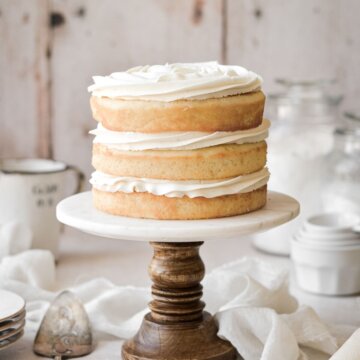
This sounds delicious, but I'm wondering if I can leave out the vinegar? Have you ever made it without? Thank you for your post.
I wouldn't leave out the vinegar. It cooks off so you don't taste it but it adds so much to recipes. I have a chocolate cake recipe that calls for it and everyone raves about it
Hello, I want to try this recipe but I didn't see an answer for using buttermilk. I use it in most my cakes and was wondering if its ok to use. Thanks
It's been answered in the comments, but yes, buttermilk is equivalent to the whole milk + vinegar combo and is fine to use.
I can't wait to try this. I have been looking for a good vanilla recipe. I feel like the recipes I have been using are dry. I have a chocolate cake recipe that is beyond moist and I just want a good vanilla one. This looks perfect. The vinegar and oil will keep it moist and the baking soda with the vinegar will keep it fluffy. I am so excited to make this
Hi, I would love to try this recipe, but I only have 9 inch pans. Can I use three 9 inch pans instead of the 3 8 inch pans? Thanks
You can, but the cake will not end up as tall.
Hi I really need a vanilla cake and this sounds perfect. Can I use 9×13 pan? I want to make it into a phone cake. Thanks!
Yes, you can! Just bake a little longer and check for doneness in the middle.
I tried your white cake and it was excellent- has a very tender crumb and wonderful flavor. My family ate it before I could even frost it! I am anxious to try your vanilla cake. I love the flavor of butter but many of the vanilla cake recipes I've tried have way too much butter and taste more like a pound cake. I notice this only has oil. I was wondering how this affects the flavor? Can a small part of the oil be substituted with real butter for a hint of added flavor? Thanks! -Jenni Ann
Yes, and actually after re-testing the recipe over the years, I prefer it with half oil and half melted butter. I left the recipe written with just oil, though, since so many people love it that way.
Can I use butter instead of oil? I only have olive oil and coconut oil.
Butter can be used instead, but it will change the texture somewhat. Butter-based cakes tend to be a little more dense, like pound cake, while vegetable oil keeps the cake fluffy and moist.
Hi! Is there a substitute for the white vinegar?
Could I sub butter for oil?
Butter can be used instead, but it will change the texture somewhat. Butter-based cakes tend to be a little more dense, like pound cake, while vegetable oil keeps the cake fluffy and moist.
I made this cake for my mother's birthday. I substituted 1 cup of the milk with hazelnut coffee creamer. I baked it in a sheet pan and cut four 5 inch circles. I put a thin layer of homemade caramel sauce between each layer. I iced it using your Buttercream recipe, using the coffee creamer instead of milk. A sprinkling of toasted pecans went on top. Everyone loved it. My daughter said it was the best cake she had ever eaten. I think the possibilities with this cake are endless. The Buttercream is spectacular, too. Not the cloying sweet from too much powdered sugar. Thank you so much for sharing this recipe.
Wow, what you did with the hazelnut creamer and the caramel sauce sounds amazing! I love when a great basic recipe can be turned into a custom creation like what you did. 🙂
Is this cake dense enough to be the bottom tier of a three tier cake?
With the top tiers supported on dowels it should be just fine!
can I substitute buttermilk for whole milk and vinegar?
Please see above comments for this question and answer. 🙂
Hello, you might have answered this but what is the vinegar for?
Please see above comments for this question and answer. 🙂
I was looking for a new recipe for a birthday cake. I think I'll try this vanilla one of yours.
Back in Aug 2018 someone asked why you separated the eggs if you added them all as wet ingredients. Hopefully I'm understanding that you don't separate, you use 2 whole eggs and another 2 egg whites,is that correct?
Yes, you're exactly right. 🙂
Heather, I just want you to know…i keep trying new Vanilla recipes…but I ALWAYS come back to this one. It's been my absolute favorite!
Thank you for sharing.
AAlso, going to attempt to use for cupcakes for the first time. Any suggestions?
This recipe works better as a layer cake than as cupcakes. I have a different recipe for Vanilla Cupcakes that I love: https://curlygirlkitchen.com/high-altitude-vanilla-cupcakes/
Can u use this recipe to make a 13 x 9 sheet cake ?
Of course!
Could you tell me if I can use this cake recipe for a Wilton Cross cake pan ?
Yes, it should work great! I don't know how long it will take to bake in the center, so just keep an eye on it for doneness. That should be the perfect Easter cake. 🙂
Thank U !!!
Is there a certain order to add the wet ingredients? Or do we mix those separately first? I’m always concerned about over mixing and I wasn’t sure if I needed to wait after each addition until it was mixed it or just dump them all in at once. Thank you!!
There's no specific order, just add them and mix. It's not a finicky recipe, so I'm sure you can't go wrong!
Please tell me how to adapt this to a 12 inch pan. Many thanks!
For how many layers? If it's for a 3-layer cake, then perhaps 1 1/2 times the recipe would be enough batter, but it may require a full double recipe. It's hard for me to say, since I don't usually make cakes that large.